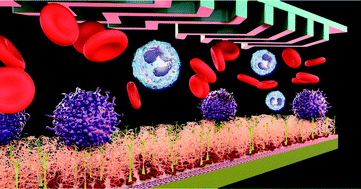Effective reduction of non-specific binding of blood cells in a microfluidic chip for isolation of rare cancer cells†
Abstract
The high purity of target cells enriched from blood samples plays an important role in the clinical detection of diseases. However, non-specific binding of blood cells in the isolated cell samples can complicate downstream molecular and genetic analysis. In this work, we report a simple solution to non-specific binding of blood cells by modifying the surface of microchips with a multilayer nanofilm, with the outmost layer containing both PEG brushes for reducing blood cell adhesion and antibodies for enriching target cells. This layer-by-layer (LbL) polysaccharide nanofilm was modified with neutravindin and then conjugated with a mixture of biotinylated PEG molecules and biotinylated antibodies. Using EpCAM-expressing and HER2-expressing cancer cells in blood as model platforms, we were able to dramatically reduce the non-specific binding of blood cells to approximately 1 cell per mm2 without sacrificing the high capture efficiency of the microchip. To support the rational extension of this approach to other applications for cell isolation and blood cell resistance, we conducted extensive characterization on the nanofilm formation and degradation, antifouling with PEG brushes and introducing functional antibodies. This simple, yet effective, approach can be applied to a variety of microchip applications that require high purity of sample cells containing minimal contamination from blood cells.



 Please wait while we load your content...
Please wait while we load your content...